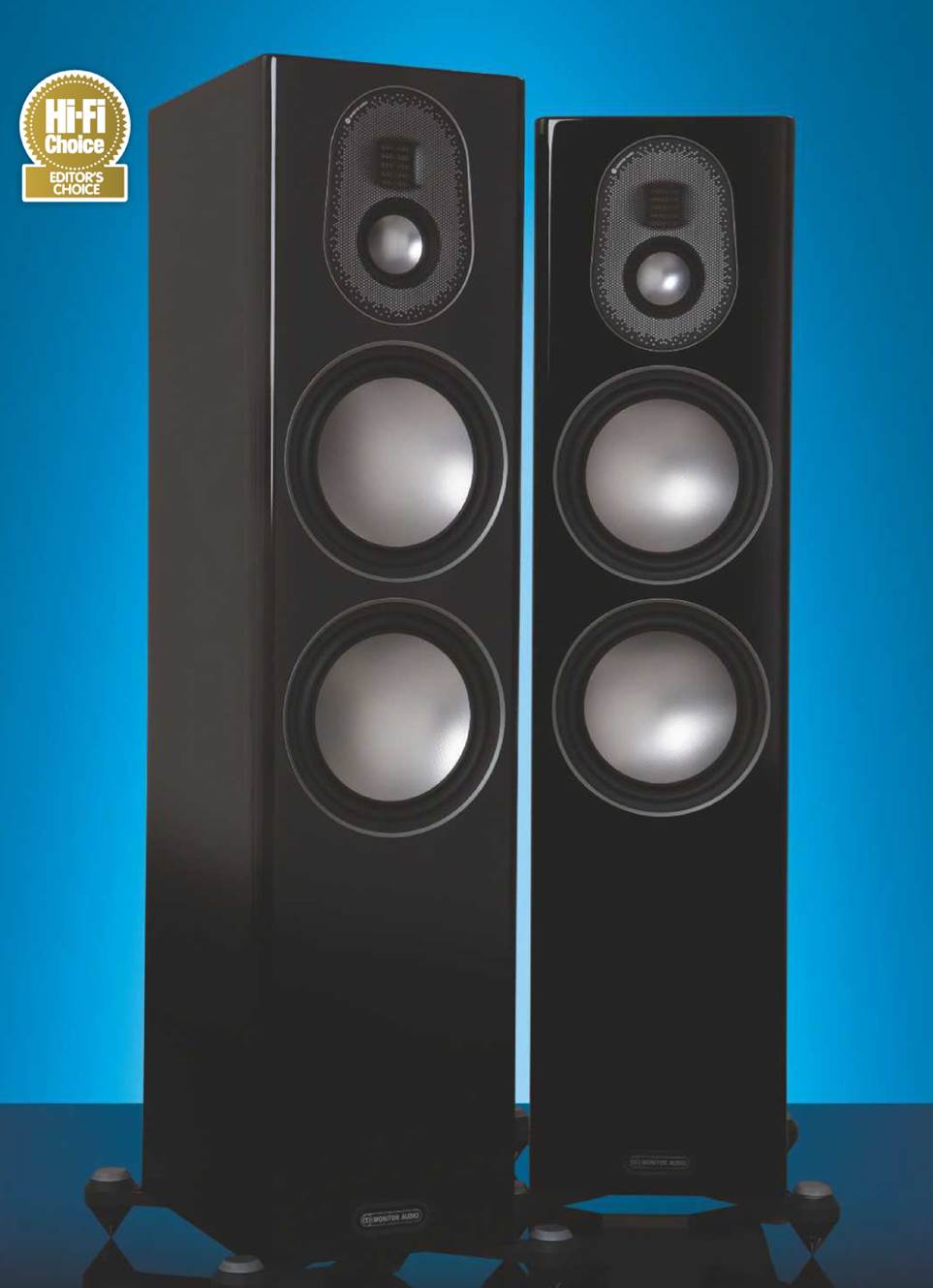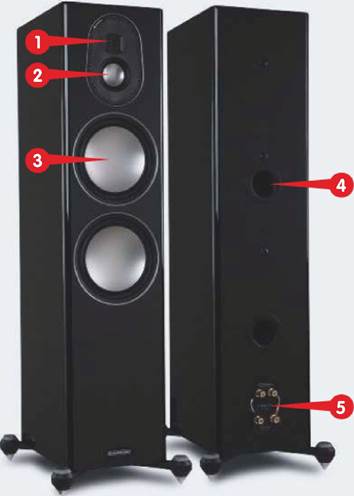Monitor Audio Gold 300 Review – Golden wonder
A true test of high art is convincing a critic who has spent years listening to various speakers.
Johannes Strom

Founded in Cambridge in 1972 by Mo Iqbal, Monitor Audio Ltd. has enjoyed an excellent reputation among enthusiasts and insiders for many years. It is frequently recommended in specialized forums. However, our editorial team had not paid much attention to the British brand in the past decade, perhaps due to multiple changes in the German distribution. It seems that the company has now found stability and renewed enthusiasm, reviving a brand that deserves more recognition. Monitor Audio can be considered the inventor of the metal chassis, and to this day, all their drivers are not only developed in England but also manufactured there. Their proprietary designs, particularly in the mid-woofer range, are noteworthy. There are no cheap imports at this traditional English company.
ORIGIN UK/China
TYPE 3-way floorstander
WEIGHT 30.6kg
DIMENSIONS (WxHxD) 328 x 1,047 x 418mm
FEATURES
• 1x MPD transducer
• 1x 64mm C-CAM midrange driver
• 2x 203mm RDT II bass drivers
• Quoted sensitivity: 90dB/1W/1m (4ohm)
DISTRIBUTOR Monitor Audio Ltd.
TELEPHONE 01268 740580
WEBSITE monitoraudio.com
The flagship of Monitor Audio’s high-end lineup is likely the Platinum series. However, the best-seller is the Silver series, which caters to ambitious beginners. The new Gold series, positioned between these two, includes the largest model, the Gold 300, which we had the opportunity to test. Now in its 5th generation, Monitor Audio shows that innovation, tradition, and the pursuit of the absolute are not contradictory. So, what are the key differences between the Silver and Gold versions? The Gold promises more resolution and a more present sound. Let’s delve into the technology behind it.
Technology
Included in the package are massive spikes that provide the speaker with a stable stand and clean decoupling. The crossover of the Gold 300 combines powerful steel-core coils and elaborate polypropylene capacitors. The internal wiring uses silver-plated PureFlow OFC copper, ensuring uncompromising quality. The cabinet, made from satin-finished white MDF in our case, is well-crafted and available in real wood veneers or black piano lacquer. The speakers are ready for bi-wiring and bi-amping, a practice highly regarded in the UK but less so in Germany, where single wiring is more common. Bridges are included and pre-installed.
With a frequency response of 30 Hz to 50 kHz at -6 dB and a sensitivity of 90 dB, the speakers promise impressive performance even with smaller amplifiers. However, the partnering amplifier should be authoritative to control the drivers, as they are demanding in terms of source quality. This demand is a mark of quality. The ultralight MPD film tweeter and midrange driver are isolated in a die-cast body and feature wave guides. Compared to the previous version, the acoustic centers of the midrange and highs are 50% closer. The 2.5″ midrange and the two 8″ bass drivers are made from a ceramic-coated aluminum-magnesium composite in a honeycomb structure, with the rear side of the membrane coated with woven carbon fiber. This combination provides outstanding rigidity and low weight.
Notably, the surrounds are inverted, bulging inward rather than outward. The drivers are tuned to ensure linear excursion up to 11 mm, double that of the predecessor. This level of engineering is awe-inspiring. Now, let’s move on to the practical check.
Sound
Our first sound impression was a classic wow effect. Where other speakers cut off reverberation, the Gold 300 begins to shine. We were surprised by the grand depth staging of the soundstage. The three-way speaker, excluding the bass-reflex ports, delivers an intoxicating resolution. The difference from conventional two-way speakers is drastic. Localization and pinpoint imaging are exceptional. If you are used to two-way speakers, you will be amazed at how well-dedicated midrange sounds and what information is missed by standard two-way boxes. The sound is particularly tactile with strings, although some may find it slightly thick between 1 and 3 kHz – a matter of taste. This can be mitigated by angling the speakers slightly outward, distributing the upper midrange and treble nicely in the room, adding to the fullness and immersion.
Regarding the bass, we can confidently say that the Gold 300 outperforms many larger speakers. They thrive when given at least 50 cm of space from the wall. The included bass plugs help control and moderate the foundation, making them suitable for smaller rooms. However, in a room of 20 square meters or larger, with open ports, the speakers deliver a concert and cinema-like experience. One of our favorite tracks for this test is “Eat The Sun Pt. I” from Oskar Rózsa’s “Under My Spell.” The track, with its range of signals from ethereal choirs to intricate percussion, is a test for any speaker. The bass and sub-bass areas are impressive, making a subwoofer unnecessary if considering a surround setup. The speakers achieve a remarkable balance – full, voluminous, and with body, yet clear and powerful, reminiscent of closed-box speakers. This could be due to the magic of Monitor Audio’s metal drivers or simply a result of superb driver tuning.

The unique MPD ribbon tweeter originates from MA’s Platinum II
IN SIGHT

1) Micro Pleated Diaphragm (MPD) HF transducer
2) 64mm C-CAM midrange driver
3) 203mm RDT II bass driver
4) HiVeII bass reflex port
5) Bi-wireable binding posts
VERDICT
There are many mediocre speakers, some very good ones, and then there are those extraordinary speakers that you remember for months or years. The Gold series is such a case. It must be heard.
Special Features
Both the tweeter and midrange are framed by a wave guide. The sensitive MPD film tweeter is also protected by a sturdy grille.
- Complex driver design
- Excellent tuning
Rating
Bass Reproduction: 20/20
Midrange Reproduction: 19/20
Treble Reproduction: 19/20
Spatial Imaging: 10/10
Sound Quality: 68/70
The bass reflex ports can be damped if needed
Build Quality/Finish: 10/10
Ease of Use: 7/10
No adjustments
Interim Score: 86 out of 90 points
Price/Performance: Very Good 9/10
Result: Reference Class 95%
Q&A
Michael Hedges
Technical director, Monitor Audio Ltd.

DV: How does the Gold 300’s RDT II driver differ from those that are used in the Platinum II?
MH: The RDT II cones used in the long-throw 203mm drivers on the Gold 300 are identical to those in the Platinum PL300 II and PL500 II. The main differences in the drivers are in the design of the magnet geometries. The design of the 203mm transducer marks a significant step forward for the Gold series introducing for the first time a 75mm voice coil with a fully vented, low-power compression design as well as the RDT II cone.
What advantages does the MPD tweeter have over a regular ribbon?
True ribbon tweeters can have an amazing sound, but power handling tends to be limited. We spent a long time developing new technologies to improve true ribbons, but fundamentally we felt the MPD design offered much more scope for improvement and had a number of better characteristics with superior power handling and lower distortion. In moving to an MPD we also made some improvements around the waveguide to make off-axis listening smoother and when combined with the new midrange driver, it offers improved room integration.
Is the small C-CAM midrange driver there to aid the transition between MPD and RDT II?
Yes, but it’s more than that. Behind the 64mm cone is a 35mm voice coil – which is very large for this size cone – coupling this with an optimised dish cone design means the first cone mode is above 10kHz. This coupled with a crossover frequency around 3kHz means that none of the modes of the cone contribute to the output of the speaker as there’s enough space for the crossover to perform its function.
The small-diameter midrange also means that at the crossover frequency the midrange is more omnidirectional than a larger 100mm design. This helps produce a smoother off-axis response enabling better integration into the room and reducing the impact of the room on the tonal balance.
HOW IT COMPARES
Excellent as the similarly priced Falcon Acoustics Studio 30 in its burr walnut finish is in this respect, it lacks the MA’s glamour and wow factor.






